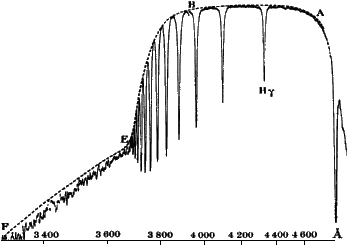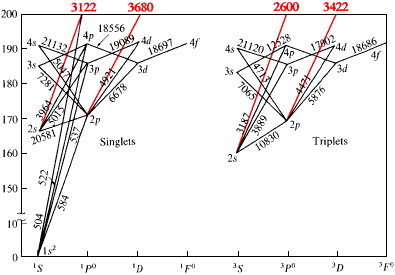 BALMER JUMP
BALMER JUMP
The 3647 Å Balmer Jump in the spectra of the hot star alpha Lyra (Vega),
observed by Barbier and Chalonge (1939).
Sir William Huggins
was the first to observe the
Balmer
jump at the turn of the century in
the stellar spectra of Vega and similar stars.
W.H. Wright observed the jump in 1918 and in 1926 his student Ch'ing Sung Yü studied
it in detail. From lab studies of hydrogen it was known that the Balmer series limit
was at 3647 Å, but Yü demonstrated that the coalescence of the higher lines of the series
often shifts the apparent discontinuity to longer wavelengths. This effect is more
pronounced at low resolution.
A decade later Barbier and Chalonge of the
Institut d'Astrophysique de Paris
measured the detailed properties of the Balmer jump.
gradients on both sides of the jump and the logarithmic intensity drop.
They found that alpha Lyra (Vega) had
the largest discontinuity, and the jump decreases for hotter or cooler spectral types.
They also found anomalous stars such as the shell star Gamma Cassiopeia with a
negative Balmer jump (sometimes called the Balmer continuum in 'emission' because the
spectra was brighter below the jump). They also noticed that line coalescence was weaker
in supergiants whose jump occurs nearer to 3647 Å.
Along with L.Divan they were able to construct a
3 dimensional
stellar classification scheme based on three parameters: The wavelength of the midpoint
of the intensity decrease (lambda_1), the logarithmic intensity drop (D) and the blue
spectral gradients between 3800 and 4800 Å (Phi_b).
The highly quantitative nature of the BCD system (Barbier-Chalonge-Divan)
is a more precise way of classifying early stars compared to the
older two dimensional spectral MK scheme still in use today (type O, B, A, F..., class
Ia, Ib, II, III,...).
COMMENTARY
In hot stars we obtain the equivalent of the Balmer jump for the helium atom,
however there are now four levels from which photoionization can occur.
These helium series limits are plotted in red in the energy level diagram below.
They indicate the wavelength thresholds for photoionization by continuum
radiation from the stellar photosphere. In shell stars
the singlet and triplet 2s
levels can become overpopulated due to their metastability, the continuous
absorption coefficient of such a nLTE gas can produce discontinuities in the
continuous spectral distribution from the star. This has been observed by
Varshni
(1985,
1988,
1989)
in several quasars, further proof that they are stars
within our galaxy.
 Helium Jumps
Helium Jumps
REFERENCES
- Balmer series
- The BCD classification system (from the
GCPD; Photometric Systems)
-
Liu,X.-W., Brlow,M.J., Danziger,I.J., Storey.P.J.: 1995, ApJ., 450, L59.
Balmer Discontinuity Temperatures in Orion Nebula
-
Werner,K.: 1996, ApJ., 457, L39.
Balmer Line Problem
- Huggins,Sir Wm.and Lady Huggins: 1899, An Atlas of Representative Stellar Spectra,
William Wesley and Son, p.85.
- Wright,W.H.: 1918, Publ. Lick Observ. 13, 191.
- Yü,C.S.: 1926, Lick Observ. Bull. 12, (no.375) 104.
-
Chalonge,D., Divan,L.: 1976, I.A.U. Symposium 72, 143.
- Varshni,Y.P.: 1989, Astrophys.Space Sci., 153, 153.
Next historical event
 BALMER JUMP
BALMER JUMP BALMER JUMP
BALMER JUMP Helium Jumps
Helium Jumps